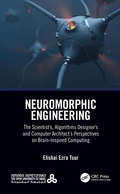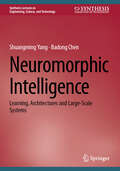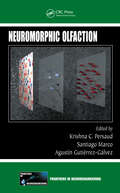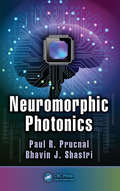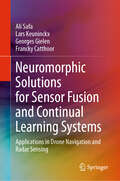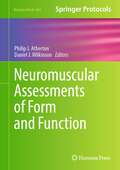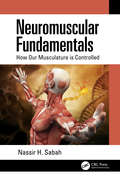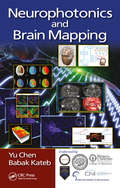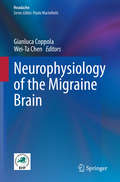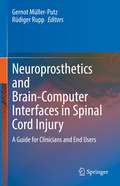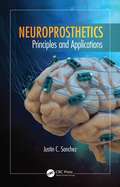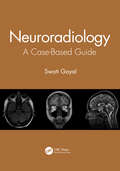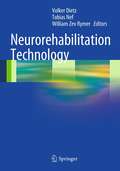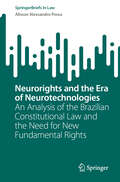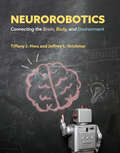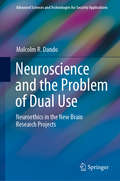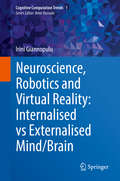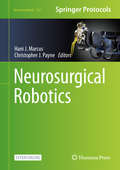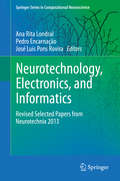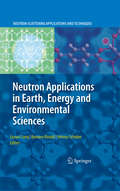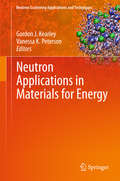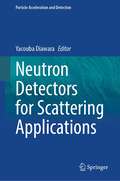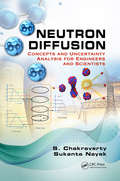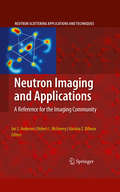- Table View
- List View
Neuromorphic Engineering: The Scientist’s, Algorithms Designer’s and Computer Architect’s Perspectives on Brain-Inspired Computing
by Elishai Ezra TsurThe brain is not a glorified digital computer. It does not store information in registers, and it does not mathematically transform mental representations to establish perception or behavior. The brain cannot be downloaded to a computer to provide immortality, nor can it destroy the world by having its emerged consciousness traveling in cyberspace. However, studying the brain's core computation architecture can inspire scientists, computer architects, and algorithm designers to think fundamentally differently about their craft. Neuromorphic engineers have the ultimate goal of realizing machines with some aspects of cognitive intelligence. They aspire to design computing architectures that could surpass existing digital von Neumann-based computing architectures' performance. In that sense, brain research bears the promise of a new computing paradigm. As part of a complete cognitive hardware and software ecosystem, neuromorphic engineering opens new frontiers for neuro-robotics, artificial intelligence, and supercomputing applications. This book will present neuromorphic engineering from three perspectives: the scientist, the computer architect, and the algorithm designer. We will zoom in and out of the different disciplines, allowing readers with diverse backgrounds to understand and appreciate the field. Overall, the book will cover the basics of neuronal modeling, neuromorphic circuits, neural architectures, event-based communication, and the neural engineering framework. Readers will have the opportunity to understand the different views over the inherently multidisciplinary field of neuromorphic engineering.
Neuromorphic Intelligence: Learning, Architectures and Large-Scale Systems (Synthesis Lectures on Engineering, Science, and Technology)
by Badong Chen Shuangming YangThis book provides a valuable resource on the design of neuromorphic intelligence, which serves as a computational foundation for building compact and low-power brain-inspired intelligent systems. The book introduces novel spiking neural network learning algorithms, including spike-based learning based on the multi-compartment model and spike-based learning with information theory. These offer important insights and academic value for readers to grasp the latest advances in neural-inspired learning. Additionally, the book presents insights and approaches to the design of scalable neuromorphic architectures, which are crucial foundations for achieving highly cognitive and energy-efficient computing systems. Furthermore, the book introduces representative large-scale neuromorphic systems and reviews several recently implemented large-scale digital neuromorphic systems by the authors, providing corresponding application scenarios.
Neuromorphic Olfaction
by Santiago Marco Krishna C. Persaud Agustín Gutiérrez-GálvezMany advances have been made in the last decade in the understanding of the computational principles underlying olfactory system functioning. Neuromorphic Olfaction is a collaboration among European researchers who, through NEUROCHEM (Fp7-Grant Agreement Number 216916)-a challenging and innovative European-funded project-introduce novel computing p
Neuromorphic Photonics
by Paul R. Prucnal Bhavin J. ShastriThis book sets out to build bridges between the domains of photonic device physics and neural networks, providing a comprehensive overview of the emerging field of "neuromorphic photonics." It includes a thorough discussion of evolution of neuromorphic photonics from the advent of fiber-optic neurons to today’s state-of-the-art integrated laser neurons, which are a current focus of international research. Neuromorphic Photonics explores candidate interconnection architectures and devices for integrated neuromorphic networks, along with key functionality such as learning. It is written at a level accessible to graduate students, while also intending to serve as a comprehensive reference for experts in the field.
Neuromorphic Solutions for Sensor Fusion and Continual Learning Systems: Applications in Drone Navigation and Radar Sensing
by Francky Catthoor Georges Gielen Ali Safa Lars KeuninckxThis book provides novel theoretical foundations and experimental demonstrations of Spiking Neural Networks (SNNs) in tasks such as radar gesture recognition for IoT devices and autonomous drone navigation using a fusion of retina-inspired event-based camera and radar sensing. The authors describe important new findings about the Spike-Timing-Dependent Plasticity (STDP) learning rule, which is widely believed to be one of the key learning mechanisms taking place in the brain. Readers will be enabled to create novel classes of edge AI and robotics applications, using highly energy- and area-efficient SNNs
Neuromorphic and Brain-Based Robots
by Hiroaki Wagatsuma Jeffrey L. KrichmarNeuromorphic and brain-based robotics have enormous potential for furthering our understanding of the brain. By embodying models of the brain on robotic platforms, researchers can investigate the roots of biological intelligence and work towards the development of truly intelligent machines. This book provides a broad introduction to this groundbreaking area for researchers from a wide range of fields, from engineering to neuroscience. Case studies explore how robots are being used in current research, including a whisker system that allows a robot to sense its environment and neurally inspired navigation systems that show impressive mapping results. Looking to the future, several chapters consider the development of cognitive, or even conscious robots that display the adaptability and intelligence of biological organisms. Finally, the ethical implications of intelligent robots are explored, from morality and Asimov's three laws to the question of whether robots have rights.
Neuromuscular Assessments of Form and Function (Neuromethods #204)
by Philip J. Atherton Daniel J. WilkinsonThis volume looks at the latest methods used to study imaging techniques, metabolic tracing, and deep muscle phenotyping. The chapters in this book cover topics such as imaging skeletal muscle mass using MRI, dual-energy x-ray absorptiometry, CT, and ultrasound; measures of neuromuscular function such as power/strength/force; microscopy and immunohistochemistry; and ex vivo fibre function and isolation. In the Neuromethods series style, chapters include the kind of detail and key advice from the specialists needed to get successful results in your laboratory. Comprehensive and thorough, Neuromuscular Assessments of Form and Function is a valuable resource for researchers interested in multiple methods used to study skeletal muscle neurophysiology.
Neuromuscular Fundamentals: How Our Musculature is Controlled
by Nassir H. SabahThis book is rather unique in its approach and coverage. The approach is essentially that of an engineering textbook, emphasizing the quantitative aspects and highlighting the fundamentals and basic concepts involved. The coverage progresses in a logical and systematic manner from the subcellular, starting with the electrophysiology of the cell membrane, then proceeding to synapses, neurons, and muscle, before considering neuronal motor ensembles and the neuromuscular system as a whole. Simple, clear, and comprehensive explanations are given throughout. After an introductory chapter on some background material in biology, biophysics, and chemical kinetics, a substantial part of the book (Chapters 2-8) necessarily covers in considerable detail the basic components and processes that underlie the electrical and associated activities of the nervous system. The remaining chapters of the book (Chapters 9-13) focus on the neuromuscular system, starting with the structure of muscle cells, the generation of force by muscular contraction, and muscle receptors. The last chapter examines aspects of the control of movement, motor learning and memory, the maintenance of posture, and locomotion, and critically examines some of the theories that have been advanced to explain how movement is controlled. The book is intended for undergraduate or graduate students in the natural sciences, mathematics, or engineering who seek a deeper understanding of the fundamentals of neuroscience and the somatomotor system, in accordance with the aforementioned objectives. The book can serve as a textbook for a one-semester course on the neuromuscular system or as a reference in a more general course on neuroscience. Provides a thorough analytical treatment of membrane electrophysiology, starting from the first principles Emphasizes strongly the basic and fundamental concepts throughout Discusses thoroughly the essential features and properties of the basic constituents of the nervous system, that is, neurons and synapses, including the neuromuscular junction Explains the main aspects of posture, locomotion, and control of movement Includes practice problems throughout the text and a solutions manual will be available for adopting professors Nassir Sabah is professor of biomedical engineering in the electrical and computer engineering department at the American University of Beirut, Lebanon. He received his B.Sc. (Hons. Class I) and his M.Sc. in electrical engineering from the University of Birmingham, U.K., and his Ph.D. in biophysical sciences from the State University of New York (SUNY/Buffalo). He has served as Chairman of the Electrical Engineering Department, Director of the Institute of Computer Studies, and Dean of the Faculty of Engineering and Architecture at the American University of Beirut. In these capacities, he was responsible for the development of programs, curricula, and courses in electrical, biomedical, communications, and computer engineering. Professor Sabah has extensive professional experience in the fields of electrical engineering, electronics, and computer systems, with more than 35 years’ teaching experience in neuroengineering, biomedical engineering, electronics, and electric circuits. He has over 100 technical publications, mainly in neurophysiology, biophysics, and biomedical instrumentation. He has served on numerous committees and panels in Lebanon and the region. He is a Fellow of the Institution of Engineering and Technology (IET, U.K.), a member of the American Association for the Advancement of Science (AAAS), and a member of the American Society for Engineering Education (ASEE).
Neurophotonics and Brain Mapping
by Yu Chen Babak KatebUnderstanding how the brain works and developing effective therapeutics are important in advancing neuroscience and improving clinical patient care. Neurophotonics and Brain Mapping covers state-of-the-art research and development in optical technologies and applications for brain mapping and therapeutics. It provides a comprehensive overview of various methods developed using light, both microscopic and macroscopic techniques. Recent developments in minimally-invasive endoscopic imaging of deep brain structure and function, as well as light-based therapy are also reviewed.
Neurophysiology of the Migraine Brain (Headache)
by Gianluca Coppola Wei-Ta ChenRoughly one in every five patients referred to a neurologist suffers from headaches; the majority have migraines. Although headache specialists understand migraine on a clinical basis, the pathophysiological changes that provoke and accompany the development of a migraine attack continue to elude us. Several decades have passed since the pioneering electroencephalographic study by Golla and Winter (1959), which underscored the role of abnormal rhythmic activities in migraine. Since then, there have been substantial advances in the field; a wealth of neurophysiological studies has enriched our understanding of the pathophysiological facets of the migraine pathology. Virtually every known technique of clinical electrophysiology has since been used to study the migraine brain and, more recently, new neurophysiological tools have been added to the arsenal. Nevertheless, applying the principles of peripheral and central neuromodulation offers a promising way to transfer the principles of synaptic plasticity to the patient’s bedside. This book belongs to the Headache Series endorsed by the European Headache Federation. Written by internationally recognized experts in their respective fields, it covers all aspects of clinical neurophysiological methods that represent significant advances in our understanding of the pathophysiology of migraine. It will offer a valuable toolkit for beginners, and a reference guide for experts.
Neuroprosthetics and Brain-Computer Interfaces in Spinal Cord Injury: A Guide for Clinicians and End Users
by Gernot Müller-Putz Rüdiger RuppThis book provides a comprehensive overview of the current state of the art of practical applications of neuroprosthesis based on functional electrical stimulation for restoration of motor functions lost by spinal cord injury and discusses the use of brain-computer interfaces for their control.The book covers numerous topics starting with basics about spinal cord injury, electrical stimulation, electrical brain signals and brain-computer interfaces. It continues with an overview of neuroprosthetic solutions for different purposes and non-invasive and invasive brain-computer interface implementations and presents clinical use cases and practical applications of BCIs. Finally, the authors give an outlook on cutting edge research with a high potential for clinical translation in the near future.All authors committed themselves to use easy-to-understand language and to avoid very specific information, focusing instead on the essential aspects. This makes this book an ideal choice not only for researchers and clinicians at all stages of their education interested in the topic of brain-computer interface-controlled neuroprostheses, but also for end users and their caregivers who want to inform themselves about the current technological possibilities to improve paralyzed motor functions.
Neuroprosthetics: Principles and Applications (Rehabilitation Science in Practice Series)
by Justin C. SanchezMaster the tools of design thinking using Neuroprosthetics: Principles and Applications. Developed from successfully tested material used in an undergraduate and graduate level course taught to biomedical engineering and neuroscience students, this book focuses on the use of direct neural sensing and stimulation as a therapeutic intervention for complex disorders of the brain. It covers the theory and applications behind neuroprosthetics and explores how neuroprosthetic design thinking can enhance value for users of a direct neural interface. The book explains the fundamentals of design thinking, introduces essential concepts from neuroscience and engineering illustrating the major components of neuroprosthetics, and presents practical applications. In addition to describing the approach of design thinking (based on facts about the user’s needs, desires, habits, attitudes, and experiences with neuroprosthetics), it also examines how effectively "human centered" neuroprosthetics can address people’s needs and interactions in their daily lives. Identifying concepts and features of devices that work well with users of a direct neural interface, this book: Outlines the signal sensing capabilities and trade-offs for common electrode designs, and determines the most appropriate electrode for any neuroprosthetic application Specifies neurosurgical techniques and how electronics should be tailored to capture neural signals Provides an understanding of the mechanisms of neural–electrode performance and information contained in neural signals Provides understanding of neural decoding in neuroprosthetic applications Describes the strategies that can be used to promote long-term therapeutic interventions for humans through the use of neuroprosthetics The first true primary text for undergraduate and graduate students in departments of neuroscience and bioengineering that covers the theory and applications behind this science, Neuroprosthetics: Principles and Applications provides the fundamental knowledge needed to understand how electrodes translate neural activity into signals that are useable by machines and enables readers to master the tools of design thinking and apply them to any neuroprosthetic application.
Neuroradiology: A Case-Based Guide
by Swati GoyalThis book covers the complete gamut of neuroradiology cases, including normal anatomy, pitfalls, and artifacts across the brain and spine in a single volume, enriched with high-resolution images that support the interpretation of CT and MRI images of the brain, spine, head, and neck. It includes case studies commonly encountered in clinical practice, in addition to normal anatomy, that prepare the reader for the challenges in the clinical setting. Each case study discusses the clinical history, relevant imaging findings, differential diagnosis, and management, serving as a helpful read for trainee radiologists, neurophysicians, neurosurgeons, and CT/MRI technicians, along with physicians interested in medical imaging. Key Features Provides a succinct overview of normal variants with case studies structured into thematic chapters Serves as a basic accompaniment for radiology residents, fellows, practicing radiologists, neurophysicians, neurosurgeons, emergency medicine practitioners, trainee and practicing radiographers, and those studying for Board exams Highlights the relevance of artificial intelligence in clinical practice
Neurorehabilitation Technology
by Tobias Nef Volker Dietz William Zev RymerNeurorehabilitation Technology provides an accessible, practical overview of the all the major areas of development and application in the field. The initial chapters provide a clear, concise explanation of the rationale for robot use and the science behind the technology before proceeding to outline a theoretical framework for robotics in neurorehabilitative therapy. Subsequent chapters provide detailed practical information on state-of-the-art clinical applications of robotic devices, including robotics for locomotion; posture and balance and upper extremity recovery in stroke and spinal cord injury. Schematic diagrams, photographs and tables will be included to clarify the information for the reader. The book also discusses standard and safety issues and future perspectives.
Neurorights and the Era of Neurotechnologies: An Analysis of the Brazilian Constitutional Law and the Need for New Fundamental Rights (SpringerBriefs in Law)
by Alisson Alexsandro PossaThis book provides an in-depth study on the theory of fundamental rights and the legal challenges posed by new technologies, with a particular focus on neurotechnologies and neurorights. The book begins with an overview of the evolution of neuroscience and neurotechnology, highlighting the current challenges these advancements pose to contemporary legal frameworks. It also discusses the potential for widespread adoption of these technologies, driven by significant investments from tech companies. The first chapter delves into the development of neuroscience and neurotechnology, emphasizing the legal implications and future concerns associated with their mass adoption. It explores how these technologies are being integrated into society and the legal challenges they present. The second chapter examines the concept of neurorights, identifying the legal objects these rights aim to protect and the new risks introduced by neurotechnologies. It provides a comprehensive review of the main neurorights proposals from recent decades, with a detailed analysis of the theoretical framework proposed by Marcello Ienca and Roberto Andorno in 2017. Their proposal includes four new human rights: cognitive freedom, mental privacy, mental integrity, and psychological continuity. The final chapter analyzes the relationship between neurorights and existing constitutional protections, focusing on the protection of human dignity. It discusses the right to free development of personality, physical and psychological integrity, and privacy and data protection. The chapter draws on theories of fundamental rights from Brazilian constitutionalists to provide a thorough examination of these issues. The book offers a broad analysis of the main neurorights proposals by international researchers, comparing them with the fundamental rights recognized in the Brazilian Constitution. It aims to determine whether new fundamental rights are necessary to protect Brazilian citizens from the potential harms of neurotechnology. This study is essential for researchers in neuroethics, neurorights, and fundamental rights, providing valuable insights into the intersection of law and emerging technologies.
Neurorobotics: Connecting the Brain, Body, and Environment (Intelligent Robotics and Autonomous Agents series)
by Jeffrey L. Krichmar Tiffany J. HwuAn introduction to neurorobotics that presents approaches and design principles for developing intelligent autonomous systems grounded in biology and neuroscience.Neurorobotics is an interdisciplinary field that draws on artificial intelligence, cognitive sciences, computer science, engineering, psychology, neuroscience, and robotics. Because the brain is closely coupled to the body and situated in the environment, neurorobots—autonomous systems modeled after some aspect of the brain—offer a powerful tool for studying neural function and may also be a means for developing autonomous systems with intelligence that rivals that of biological organisms. This textbook introduces approaches and design principles for developing intelligent autonomous systems grounded in biology and neuroscience. It is written for anyone interested in learning about this topic and can be used in cognitive robotics courses for students in psychology, cognitive science, and computer science.Neurorobotics covers the background and foundations of the field, with information on early neurorobots, relevant principles of neuroscience, learning rules and mechanisms, and reinforcement learning and prediction; neurorobot design principles grounded in neuroscience and principles of neuroscience research; and examples of neurorobots for navigation, developmental robotics, and social robots, presented with the cognitive science and neuroscience background that inspired them. A supplementary website offers videos, robot simulations, and links to software repositories with neurorobot examples.
Neuroscience and the Problem of Dual Use: Neuroethics in the New Brain Research Projects (Advanced Sciences and Technologies for Security Applications)
by Malcolm R. DandoThis book discusses recent brain research and the potentially dangerous dual-use applications of the findings of these research projects. The book is divided into three sections: Part I examines the rise in dual-use concerns within various state’s chemical and biological non-proliferation regime’s during this century, as well as the rapid technologically driven advances in neuroscience and the associated possible misuse considerations in the same period. Part II reviews the brain research projects in the EU, USA, Japan, China and several other countries with regard to their objectives, achievements and measures to deal with the problem of dual-use. Part III assesses the extent to which the results of this civil neuroscience work, which is intended to be benign, are being, and could be protected against future hostile applications in the development of novel chemical and biological weapons.
Neuroscience, Robotics and Virtual Reality: Internalized Vs Externalized Mind/brain (Cognitive Computation Trends #1)
by Irini GiannopuluThis is the first volume in the Cognitive Computation Trends book series, summarising our understanding on the neural correlate of memory, perception-representation, action, language, emotion and consciousness and their mutual interactions. Integrating research in the field of the Neuroscience, Robotics and Virtual Reality, this book is an original and attainable resource that has not been developed in any other writing. In 5 chapters, the author considers that representations are based on allegorical traces and are consciously and/or unconsciously embrained, and that the creation of robots is the expression of the mind. Whole-body virtual motion is thought of as the archetypal expression of virtual reality. Therefore, visual reality is analysed in a context of visuo-vestibular and somesthetic conflict while mixed and augmented reality are scrutinised in a context of visuo-vestibular and somesthetic interaction. This monograph is an indispensable handbook for students and investigators engaged in history of science, philosophy, psychology, neuroscience, engineering and those interested in there interconnections. The ambition of the book is to give students and investigators ideas on which they can build their future research in this new blooming area.
Neurosurgical Robotics (Neuromethods #162)
by Hani J. Marcus Christopher J. PayneThis volume introduces engineers and healthcare professionals to the latest in neurosurgical robotic technology. The chapters in this book are organized into two parts and cover basic engineering concepts that underpin surgical robotics; various robotic platforms and how these systems make their way to the clinic; popular applications of surgical robots in neurosurgery within subspecialties; and a discussion on the future development of neurosurgical robotic systems. In the Neuromethods series style, chapters include the kind of detail and key advice from the specialists needed to get successful results in your clinic. Cutting-edge and thorough, Neurosurgical Robotics is a valuable resources for scientists and engineers interested in learning more about this fascinating and developing field.
Neurotechnology, Electronics, and Informatics
by Ana Rita Londral Pedro Encarnação José Luis Pons RoviraThe International Congress on Neurotechnology, Electronics, and Informatics (NEUROTECHNIX) took place in Algarve, Portugal in September of 2013. The congress provided a meeting point of academics and clinical and engineering professionals, promoting translational discussions on how research and technology can meet the needs of clinical practitioners and patients. NEUROTECHNIX emphasized research and application of neurotechnologies to various neurological disorders, including neuromuscular diseases, Parkinson's disease, developmental disorders, dementia, epilepsy, sleep disorders, Multiple Sclerosis, neuroinfections, brain tumors, stroke, traumatic brain injuries, Cerebral Palsy, spinal cord injury and vision and hearing disorders. Authors were invited to submit innovative research work that highlighted new advancements of neurotechnology. Papers describing case studies, advanced prototypes, systems, tools and techniques and general survey papers indicating future directions were encouraged. This book contains a limited selection of extended and revised versions of the best papers presented at the congress, by regular and keynote speakers.
Neutron Applications in Earth, Energy and Environmental Sciences
by Romano Rinaldi Liyuan Liang Helmut SchoberNeutron Applications in Earth, Energy and Environmental Sciences offers a comprehensive overview of the wide ranging applications of neutron scattering techniques to elucidate the fundamental materials properties at the nano-, micro- and meso-scale, which underpin research in the related fields of Earth, Energy and Environmental Sciences. Introductions to neutron scattering fundamentals and instrumentation are paired with a thorough review of the applications to a large variety of scientific and technological problems, written through the direct experience of leading scientists in each field. Tailored to a wide audience, this volume provides the novice with an inspiring introduction and stimulates the expert to consider these non-conventional problem solving techniques in his/her field of interest. Earth and environmental scientists, engineers, researchers and graduate students involved with materials science will find Neutron Applications in Earth, Energy and Environmental Sciences a valuable ready-to-use reference.
Neutron Applications in Materials for Energy
by Gordon J. Kearley Vanessa K. PetersonNeutron Applications in Materials for Energy collects results and conclusions of recent neutron-based investigations of materials that are important in the development of sustainable energy. Chapters are authored by leading scientists with hands-on experience in the field, providing overviews, recent highlights, and case-studies to illustrate the applicability of one or more neutron-based techniques of analysis. The theme follows energy production, storage, and use, but each chapter, or section, can also be read independently, with basic theory and instrumentation for neutron scattering being outlined in the introductory chapter. Whilst neutron scattering is extensively used to understand properties of condensed matter, neutron techniques are exceptionally-well suited to studying how the transport and binding of energy and charge-carrying molecules and ions are related to their dynamics and the material's crystal structure. These studies extend to in situ and in operando in some cases. The species of interest in leading energy-technologies include H2, H+, and Li+ which have particularly favourable neutron-scattering properties that render these techniques of analysis ideal for such studies and consequently, neutron-based analysis is common-place for hydrogen storage, fuel-cell, catalysis, and battery materials. Similar research into the functionality of solar cell, nuclear, and CO2 capture/storage materials rely on other unique aspects of neutron scattering and again show how structure and dynamics provide an understanding of the material stability and the binding and mobility of species of interest within these materials. Scientists and students looking for methods to help them understand the atomic-level mechanisms and behaviour underpinning the performance characteristics of energy materials will find Neutron Applications in Materials for Energy a valuable resource, whilst the wider audience of sustainable energy scientists, and newcomers to neutron scattering should find this a useful reference.
Neutron Detectors for Scattering Applications (Particle Acceleration and Detection)
by Yacouba DiawaraThis book covers the most common neutron detectors used in neutron scattering facilities and all of those in use at Oak Ridge National Lab. It starts describing the facilities, instruments and the critical detector parameters needed by various instruments. Then the key components of the 3He-based linear position-sensitive detectors as well as on their electronics, which require particular attention to signal processing and noise reduction, are introduced. One chapter is dedicated to the 3He alternatives where scintillators play a critical role. It also covers emerging neutron detection technologies including semiconductors, vacuum-based devices and their associated readouts, which will be required in the future for high rate and high-resolution neutron detectors.The authors explain the logic behind the choice of materials as well as the various constraints that neutron detectors must respect to be useful. Some of these constraints, such as efficiency and gamma-ray sensitivity are common to all neutron counters while others, like timing resolution, dynamic range, and peak counting rate, depend on the applications.The book guides experts, the nuclear science community, and young scholars through the physical processes and the required electronics in a way that is accessible for those not professionally involved in designing detector’s components and electronic circuits.
Neutron Diffusion: Concepts and Uncertainty Analysis for Engineers and Scientists
by S. Chakraverty Sukanta NayakThis book is designed for a systematic understanding of nuclear diffusion theory along with fuzzy/interval/stochastic uncertainty. This will serve to be a benchmark book for graduate & postgraduate students, teachers, engineers and researchers throughout the globe. <P><P> In view of the recent developments in nuclear engineering, it is important to study the basic concepts of this field along with the diffusion processes for nuclear reactor design. Also, it is known that uncertainty is a must in every field of engineering and science and, in particular, with regards to nuclear-related problems. As such, one may need to understand the nuclear diffusion principles/theories corresponding with reliable and efficient techniques for the solution of such uncertain problems. Accordingly this book aims to provide a new direction for readers with basic concepts of reactor physics as well as neutron diffusion theory. On the other hand, it also includes uncertainty (in terms of fuzzy, interval, stochastic) and their applications in nuclear diffusion problems in a systematic manner, along with recent developments. The underlying concepts of the presented methods in this book may very well be used/extended to various other engineering disciplines viz. electronics, marine, chemical, mining engineering and other sciences such as physics, chemistry, biotechnology etc. This book then can be widely applied wherever one wants to model their physical problems in terms of non-probabilistic methods viz. fuzzy/stochastic for the true essence of the real problems.
Neutron Imaging and Applications
by Ian S. Anderson Robert Mcgreevy Hassina Z. BilheuxNeutron Imaging and Applications offers an introduction to the basics of neutron beam production in addition to the wide scope of techniques that enhance imaging application capabilities. An instructional overview of neutron sources, detectors, optics and spin-filters allows readers to delve more deeply into the discussions of radiography, tomography and prospective applications available in neutron holography techniques. A section devoted to current applications describes imaging single grains in polycrystalline materials, neutron imaging of geological materials and other materials science and engineering areas. Coverage of thermal neutron imaging of biological tissues, plant physiology, Homeland Security and contraband detection explore the future prospects of this cutting-edge research. Written by key experts in the field, researchers and engineers involved with imaging technologies will find Neutron Imaging and Applications a valuable reference.
